This EduRev document offers 20 Multiple Choice Questions (MCQs) from the topic Number System (Level - 2). These questions are of Level - 2 difficulty and will assist you in the preparation of CAT & other MBA exams. You can practice/attempt these CAT Multiple Choice Questions (MCQs) and check the explanations for a better understanding of the topic.
Question for Practice Questions Level 2: Data Sufficiency - 2
Try yourself:Directions: In the following problem, a question followed by three statements (I), (II) and (III) is given. You have to determine which statement(s) is/are sufficient/necessary to answer the question.
A, B, C, D, E, F and G appeared for a test and all scored different marks. B stood third in the test result.
Q. How many students scored more than G?
I. A scored more than B. E scored more than only two students.
II. G scored half the marks, which C scored and D scored half the marks as that of G.
III. F did not score more than E. G scored less than C.
Explanation

Using any two of the statements, there are numerous possibilities.
Using all three statements, we get that all three statements are required to answer the question.
Report a problem
Question for Practice Questions Level 2: Data Sufficiency - 2
Try yourself:Directions: In the following problem, a question followed by three statements (I), (II) and (III) is given. You have to determine which statement(s) is/are sufficient/necessary to answer the question.
D, E, F, G, H and I are six members of a family. There are two couples in the family. E has two children.
Q. How is G related to E?
I. D is the son-in-law of G. I is the niece of F.
II. H is the daughter of E. D is the brother-in-law of F.
III. E is the father of F. D has no sibling.
Explanation
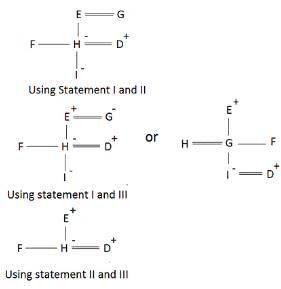
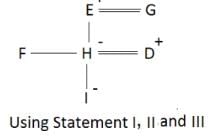
Using statements I, II and III, we can know the gender of G and hence, the relation with D.
Note : Using I and III, there are 2 possibilities and by second possibility, we cannot determine the gender.
Report a problem
Question for Practice Questions Level 2: Data Sufficiency - 2
Try yourself:Directions: In the following problem, a question followed by three statements (I), (II) and (III) is given. You have to determine which statement(s) is/are sufficient/necessary to answer the question.
I, J, K, L, M, N and O are seven siblings and none of them are twins. J is the eldest and O is the middle one.
Q. Who was/were born after L?
I. Two were born between K and M.
II. I was born before K and M.
III. L was born before N, but not immediately before N.
Explanation
Using all three statements, we get
J > I > K/M > O > L > K/M > N
We cannot answer the question even using all the three statements.v
Report a problem
Question for Practice Questions Level 2: Data Sufficiency - 2
Try yourself:Directions: The following problem contains a question and statements numbered I, II and III. Read the statements carefully and determine which of them is/are sufficient/required to answer the question.
Q. How is A related to B?
I. B is married to C, who is a parent of A.
II. A is the grandson of D, who is the father of B.
III. A is the brother of E, who is the granddaughter of the mother of B.
Explanation
From I, we deduce that B is a parent of A.
From II, we deduce the gender of A and from this, we get that A is either the son or the nephew of B.
From III, again it can be deduced that A is a male and from this, we get that A is either the son or the nephew of B.
Hence, using statement I and either II or III, we can conclude A is the son of B.
Report a problem
Question for Practice Questions Level 2: Data Sufficiency - 2
Try yourself:Directions: The following problem contains a question and three statements numbered I, II and III. Read the statements carefully and determine which of them is/are sufficient/required to answer the question.
Q. Between P and Q, who scored more marks?
I. P scored more marks than R did, but less than S did.
II. S scored the highest marks among P, Q, R and S.
III. Q scored less marks than R did.
Explanation
From I:
S > P > R
From II:
S scored the highest marks.
From III:
R > Q
From I and III:
P > R > Q
It implies that:
P > Q
Hence, only statements I and III are sufficient to answer the question.
Report a problem
Question for Practice Questions Level 2: Data Sufficiency - 2
Try yourself:Directions: The following question is accompanied by three statements (I), (II) and (III). You have to determine which statement(s) is/are sufficient/necessary to answer the question.
Six friends A, B, C, D, E and F are sitting around a circular table facing one of the other person.
Q. What is the position of C with respect to A?
I. A is facing E, who is sitting immediate to the left of B.
II. D and F are immediate neighbours.
III. C is facing F.
Explanation

Using statements I and II only, we can get the exact position of A and C.
Report a problem
Question for Practice Questions Level 2: Data Sufficiency - 2
Try yourself:Directions: The question given below is followed by three statements (I), (II) and (III). You have to determine which of the statements is/are sufficient/necessary to answer the question.
Seven students James, Vicky, Vikram, Rahul, Shilpa, Priya and Sachin take a test and scored different marks. James scored more than 4 students.
Q. Who scored the highest marks?
I. Shilpa scored less than Priya but more than Vicky.
II. Rahul scored more than Sachin but not more than James.
III. James scored less than Priya but more than Rahul.
Explanation
Using all three statements:
Priya > Shilpa > Vicky
Priya > James > Rahul > Sachin
__ > __ > James > __ > __ > __ > __
Either Priya or Vikram scored the highest.
All three statements together are not enough.
Report a problem
Question for Practice Questions Level 2: Data Sufficiency - 2
Try yourself:Directions: The question given below is followed by three statements (I), (II) and (III). You have to determine which of the statements is/are sufficient/necessary to answer the question.
A, B, C, D, E and F are six members of a family out of which two are couples. D, who is not married is the brother-in-law of C. A is married, but F is not the wife of A. E is not married.
Q. How is E related to B and how is C related to B?
I. C is the mother of E.
II. C is the daughter-in-law of A.
III. E is the granddaughter of A, who has two sons.
Explanation
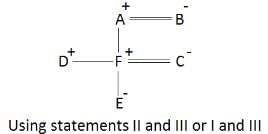
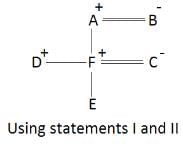
Statements III and either I or II are required to answer the question.
Report a problem
Question for Practice Questions Level 2: Data Sufficiency - 2
Try yourself:Directions: The following question is accompanied by three statements (I), (II) and (III). You have to determine which statement(s) is/are sufficient/necessary to answer the question.
Raj and Sam are standing in a row facing same direction. Raj is 15th from right and Sam is 14th from left.
Q. How many persons are there in the row?
I. If Sam shifts 5 places to the left then there will be 7 persons between Raj and Sam.
II. There are 12 persons between Sam and Raj.
III. If Raj shifts 5 places to the right then there will be 7 persons between Raj and Sam.
Explanation
Using any one of the statements we cannot determine if Raj is to the left of Sam or to the right of Sam.
When we combine statement II with other two statements we get to know that Raj is to the left of Sam and there are 12 persons between them.
Hence, in total there are 15 persons in the row.
Thus, Only statements II and either I or III are sufficient.
Report a problem
Question for Practice Questions Level 2: Data Sufficiency - 2
Try yourself:Directions: In this problem, a question is followed by three statements numbered (I), (II), and (III). Read the statements carefully and determine which of them is/are sufficient/necessary to answer the question.
Q. How is Simar related to Raj?
I. Raj said to Simar, "You are the mother of the nephew of my only sister". Raj has one sibling.
II. Raj said to Simar, "Your father-in-law is the grandfather of my son".
III. Raj said to Simar, "I am the only son of the wife of your father-in-law".
Explanation
Using statement I:
As Raj has only one sibling, So the nephew of my only sister is my son
Then mother of my son is my wife
So, Simar will be Raj's wife
Using statement II:
Simar can be Raj's wife, wife of Raj's brother or husband of Raj's sister.
Using statement III:
Simar can be Raj's wife or husband of Raj's sister.
So, from statement I only, we get that Simar is the wife of Raj.
Report a problem
Question for Practice Questions Level 2: Data Sufficiency - 2
Try yourself:Directions: The question given below is followed by three statements (I), (II) and (III). You have to determine which of the statements is/are sufficient/necessary to answer the question.
D is 10 m to the west of E, who is 5 m to the north of F.
Q. What is the distance between M and N?
I. M is 10 m to the south of D, who is 5 m to the east of S.
II. N is 5 m to the south of F, who is 10 m to the east of Q.
III. M is 5 m to the south of Q, who is 5 m to the south of D.
Explanation

Statements II and either I or III are required to answer the question.
Report a problem
Question for Practice Questions Level 2: Data Sufficiency - 2
Try yourself:Directions: The question given below is followed by three statements (I), (II) and (III). You have to determine which of the statements is/are sufficient/necessary to answer the question.
Q. What is the distance between P and B?
I. P is 7 m to the south of D, who is 5 m to the west of K, who is 10 m to the north of Z.
II. A is 5 m to the south of Z, who is 5 m to the east of B.
III. J is 3 m to the west of B and 10 m to the south of H, who is 8 m to the west of K.
Explanation

Statements I and either II or III are required to answer the question.
Report a problem
Question for Practice Questions Level 2: Data Sufficiency - 2
Try yourself:Directions: The question given below is followed by three statements (I), (II) and (III). You have to determine which of the statements is/are sufficient/necessary to answer the question.
There are seven friends Atul, Vicky, Vijay, Amar, Hiten, Rohit and Raj of different heights.
Q. Who among them is the shortest?
I. Atul is taller than Vicky but shorter than Raj. Vicky is not the shortest.
II. Hiten is taller than one person only. Only Vijay is taller than Amar.
III. There are three persons who are taller than Rohit but shorter than Raj.
Explanation
Using statement I:
Raj > Atul > Vicky
Using statement II:
Vijay > Amar >__>__>__> Hiten >__
Using statement III:
Raj > __>__>__> Rohit
Using statements I and II:
Vijay > Amar > Raj > Atul > Vicky > Hiten > Rohit
Using statements II and III:
Vijay > Amar > Raj > Atul/Vicky > Hiten > Rohit
Using statements I and III:
Any one of Vijay, Rohit and Amar can be the shortest.
Only statements II and either I or III are sufficient.
Report a problem
Question for Practice Questions Level 2: Data Sufficiency - 2
Try yourself:rections: In the following problem, a question followed by three statements (I), (II) and (III) is given. You have to determine which statement(s) is/are sufficient/necessary to answer the question.
In a certain code language, 'people are not bad' is written as 're le to da' and 'give me some food' is written as 'me mi mo do'.
Q. How is 'nice me' written in that code language?
I. In that code language, 'this food is tasty' is written as 'do si so sa'.
II. In that code language, 'give me some money' is written as 'mo mi yo me'.
III. In that code language, 'some people are nice' is written as 'mo le ni re'.
Explanation
Using all the statements, we cannot find the exact code for 'me'.
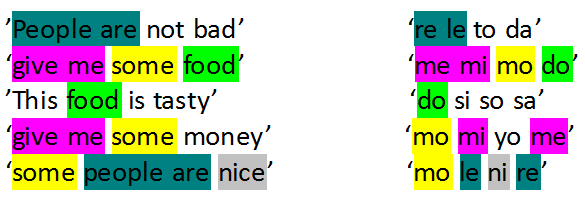
Report a problem
Question for Practice Questions Level 2: Data Sufficiency - 2
Try yourself:Directions: In the following problem, a question followed by three statements (I), (II) and (III) is given. You have to determine which statement(s) is/are sufficient/necessary to answer the question.
In a certain code language, 'what' is written as 'ta', how is 'day time' written in that code language? (Sequence of codes does not matter)
Q. I. In that code language, 'how was your day' is written as 'ry as wo yo' and 'give me some time' is written as 'mo ni me mi'.
II. In that code language, 'what time of day' is written as 'mi ta if ry' and 'how is your work' is written as 'so wo yo la'.
III. In that code language, 'time is not good' is written as 'so mi to do' and 'good time of you' is written as 'mi do if xo'.
Explanation
Using statements I and II:
'How was your day' and 'what time of day' have only one word common, which is day.
Hence, code for 'day' is 'ry'
'Give me some time' and 'what time of day' has only one word common, which is 'time'.
Hence, code for 'time' is 'mi'.
Using statements I and III:
We do not have any sentence, which has common words of sentence 'how was your day', hence we cannot find the code for day.
Using statements II and III:
Word 'time' is common in three sentences, hence code for 'time' is 'mi'.
'What time of day' and 'Good time of you' have common words 'time' and 'of'. Also, code for 'what' is known.
Hence, from 'what time of day', code for 'day' is 'ry'.
Statement II and either I or III are sufficient to answer the question.
Report a problem
Question for Practice Questions Level 2: Data Sufficiency - 2
Try yourself:Directions: In the following problem, a question followed by three statements (I), (II) and (III) is given. You have to determine which statement(s) is/are sufficient/necessary to answer the question.
There are 6 members in a family - M, N, O, P, Q and R. There are two couples in the family and M is the grandfather of R.
Q. Who is the wife of Q?
I. Q is not married to P.
II. R is not married.
III. O is the sister-in-law of N, who is the daughter-in-law of P.
Explanation
Using statement III alone, there arise two possibilities.
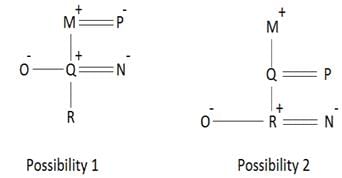
Using either statement I or II, possibility 2 can be denied and hence, we get the answer.
Report a problem
Question for Practice Questions Level 2: Data Sufficiency - 2
Try yourself:Directions: The following problem contains a question and statements numbered I, II and III. Read the statements carefully and determine which of them is/are sufficient/required to answer the question.
Q. What is the colour of A's house?
I. A, B and C have houses of different colours and those are red, white and blue, in no particular order.
II. A does not live in the white-coloured house and B lives in the red-coloured house.
III. C lives in the white-coloured house.
Explanation
Statement I gives data about colours.
From II, we can infer that A does not live in the white or the red-coloured house.
Hence, A must live in the blue-coloured house.
Hence, option (3) is the answer.
Report a problem
Question for Practice Questions Level 2: Data Sufficiency - 2
Try yourself:Directions: The question given below is followed by three statements (I), (II) and (III). You have to determine which of the statements is/are sufficient/necessary to answer the question.
In a queue, Inder and Simu are standing with some other students where Simu is 14th from front and Inder is standing ahead of Simu.
Q. How many students are there in the queue?
I. The number of students standing ahead of Inder is 3 times the number of students standing between Inder and Simu.
II. The number of persons standing behind Simu is double the number of persons standing between Inder and Simu.
III. The number of persons standing behind Inder is one more than the number of persons standing ahead of Inder.
Explanation
Using statement I:
Let the number of students between Inder and Simu be x.
Number of students ahead of Inder = 3x
So, 3x +x + 1 = 13
x = 3
Using statements I and II:
Number of students behind Simu = 2x = 6
Total number of students = 14 + 6= 20
Using statements I and III:
Number of students ahead of Inder = 3x = 9
Number of students behind inder = 9 + 1 = 10
Total number of students = 9 + 1 + 10 = 20
Using statements II and III,
From statement II, we get
Number of person after simu = 2x
Total number of persons = 14 + 2x .....(1)
Also from statement III,we get:
Number of persons before Inder = 12-x
Number of persons after Inder = 12-x + 1
Total number of persons = 12 - x + 1 + 1 ....(2)
By equalising (1) and (2), total number of persons = 20
So, any two statements can be used to answer the question.
Report a problem
Question for Practice Questions Level 2: Data Sufficiency - 2
Try yourself:Directions: In this problem, a question is followed by three statements, labelled as (A), (B) and (C). Read the statements carefully and determine which of them is/are sufficient/necessary to answer the question.
Q. What is the length of the platform?
(A) The train crosses a woman standing on the platform in 35 seconds.
(B) The train passes a station platform in 50 seconds and speed of the train is 72 km/hr.
(C) The length of the train is 700 m.
Explanation
From statement (B):
Speed of train =  m/s = 20 m/s
m/s = 20 m/s
From statement (A):
Time taken to cross the woman = 35 seconds
Thus, from (A) + (B), we have:
Length of train = 20 × 35 = 700 m
Let the length of platform be x metres.
Thus, total length = x + 700 m
Then, Speed = Length/Time

or, 1000 = x + 700
or, x = 300 m
Thus, length of platform is 300 m.
From (C): Length of the train is 700 m.
This statement alone is not necessary to find the length of the platform.
Thus, only statements A and B together are sufficient.
Report a problem
Question for Practice Questions Level 2: Data Sufficiency - 2
Try yourself:Directions: The question given below is followed by three statements (I), (II) and (III). You have to determine which of the statements is/are sufficient/necessary to answer the question.
Q. How is “time” coded in the code language?
I. In the code language, “some time is needed” is coded as “te de si me”.
II. In the code language, “is time not money” is coded as “te mo si ne”.
III. In the code language, “give me some time” is coded as “me mi te le”.
Explanation
Using statements I and II:
”Time’ coded as “te” or “si”.
Using statements II and III:
”Time” is coded as “te”
Using statements I and III:
”Time” is coded as “te” or “me”
Hence, statements II and III are sufficient to answer the question.
Report a problem











 m/s = 20 m/s
m/s = 20 m/s



















